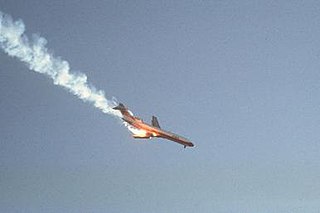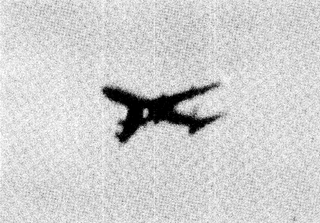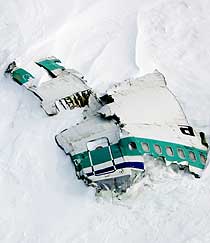
American Airlines Flight 587 was a regularly scheduled international passenger flight from John F. Kennedy International Airport, New York City, to Las Américas International Airport, Santo Domingo. On November 12, 2001, the Airbus A300B4-605R flying the route crashed into the neighborhood of Belle Harbor on the Rockaway Peninsula of Queens, New York City, shortly after takeoff, killing all 260 people aboard, as well as five people on the ground. It is the second-deadliest aviation accident to have occurred in the United States of America, behind the crash of American Airlines Flight 191 in 1979, and the second-deadliest aviation incident involving an Airbus A300, after Iran Air Flight 655.

The Tenerife airport disaster occurred on 27 March 1977, when two Boeing 747 passenger jets collided on the runway at Los Rodeos Airport on the Spanish island of Tenerife. The accident occurred when KLM Flight 4805 initiated its takeoff run in dense fog, colliding with the right side of Pan Am Flight 1736 still on the runway. The impact and the resulting fire killed all 248 people on board the KLM plane and 335 of the 396 people on board the Pan Am plane, with only 61 survivors in the front section of the latter aircraft. With a total of 583 fatalities, the disaster is the deadliest accident in aviation history.

An aviation accident is an event during aircraft operation that causes serious injury, death, or destruction. An aviation incident is any operating event that compromises safety but does not progress to an aviation accident. Preventing accidents and incidents is the main goal of aviation safety.

American Airlines Flight 191 was a regularly scheduled domestic passenger flight from O'Hare International Airport in Chicago to Los Angeles International Airport. On the afternoon of May 25, 1979, the McDonnell Douglas DC-10 operating this flight was taking off from runway 32R at O'Hare International when its left engine detached from the wing, causing a loss of control. The aircraft crashed about 4,600 feet (1,400 m) from the end of runway 32R. All 271 occupants on board were killed on impact, along with two people on the ground. With a total of 273 fatalities, the disaster is the deadliest aviation accident to have occurred in the United States.

Turkish Airlines Flight 981 (TK981/THY981) was a scheduled flight from Istanbul Yeşilköy Airport to London Heathrow Airport, with an intermediate stop at Orly Airport in Paris. On 3 March 1974, the McDonnell Douglas DC-10 operating the flight crashed into the Ermenonville Forest, 37.76 kilometres (23.46 mi) outside Paris, killing all 335 passengers and 11 crew on board. It was the first aviation accident to exceed 200 and 300 fatalities. The crash was also known as the Ermenonville air disaster.

The Kegworth air disaster occurred when British Midland Airways Flight 092, a Boeing 737-400, crashed onto the motorway embankment between the M1 motorway and A453 road near Kegworth, Leicestershire, England, while attempting to make an emergency landing at East Midlands Airport on 8 January 1989.

Pacific Southwest Airlines Flight 182 was a scheduled flight on September 25, 1978, by Pacific Southwest Airlines (PSA), from Sacramento to San Diego (SAN), with a stopover at Los Angeles (LAX). The aircraft serving the flight, a Boeing 727-214, collided mid-air with a private Cessna 172 over San Diego. It was Pacific Southwest Airlines' first fatal accident, and it remains the deadliest air disaster in California history. At the time, it was the deadliest air crash to occur in the United States, and remained so until the crash of American Airlines Flight 191 in May 1979.

Japan Air Lines Flight 123 was a scheduled domestic passenger flight from Tokyo to Osaka, Japan. On August 12, 1985, the Boeing 747 flying the route suffered a severe structural failure and decompression 12 minutes into the flight. After flying under minimal control for a further 32 minutes, it crashed in the area of Mount Takamagahara, 100 kilometres from Tokyo.

The Mount Erebus disaster occurred on 28 November 1979 when Air New Zealand Flight 901 (TE901) flew into Mount Erebus on Ross Island, Antarctica, killing all 237 passengers and 20 crew on board. Air New Zealand had been operating scheduled Antarctic sightseeing flights since 1977. This flight left Auckland Airport in the morning and was supposed to spend a few hours flying over the Antarctic continent, before returning to Auckland in the evening via Christchurch.

United Air Lines Flight 409 was a scheduled flight which originated in New York City, New York. The final flight destination was San Francisco, California, with stops in Chicago, Denver and Salt Lake City. The aircraft operating the service, a Douglas DC-4 propliner, registered as N30062, crashed into Medicine Bow Peak, near Laramie, Wyoming, on October 6, 1955, killing all 66 people on board. The victims included five female members of the Mormon Tabernacle Choir and military personnel. At the time, this was the deadliest airline crash in the history of American commercial aviation. Another 66 lives had been lost earlier that year in the March 22 crash in Hawaii of a United States Navy Douglas R6D-1 Liftmaster military transport aircraft, and 66 had also died in the mid-air collision of two United States Air Force C-119G Flying Boxcars over West Germany on August 11, placing the three crashes in a three-way tie as the deadliest aviation incidents in 1955.

BOAC Flight 911 was a round-the-world flight operated by the British Overseas Airways Corporation (BOAC) that crashed near Mount Fuji in Japan on 5 March 1966, with the loss of all 113 passengers and 11 crew members. The Boeing 707 flying the route disintegrated mid-air shortly after departing from Tokyo Haneda Airport as a result of severe clear-air turbulence.

All Nippon Airways (ANA) Flight 60 was a Boeing 727-81 aircraft making a domestic commercial flight in Japan from Sapporo Chitose Airport to Tokyo Haneda International Airport. On February 4, 1966, all 133 people on board died when the plane mysteriously crashed into Tokyo Bay about 10.4 km from Haneda in clear weather conditions while on a night approach. The accident was the worst involving a single aircraft in Japan and also the deadliest accident in the country until All Nippon Airways Flight 58 crashed five years later, killing 162 people.

On March 4, 1966, Canadian Pacific Air Lines Flight 402 (CP402) struck the approach lights and a seawall during a night landing attempt in poor visibility at Haneda Airport in Tokyo, Japan. Of the 62 passengers and 10 crew, only 8 passengers survived.

The Llandow air disaster was an aircraft accident in Wales in 1950. At that time it was the world's worst air disaster, with a total of 80 fatalities. The aircraft, an Avro Tudor V, had been privately hired to fly rugby union enthusiasts to and from an international game in Ireland. On the return flight the aircraft stalled and crashed on its approach to land.

Mount Takamagahara is a mountain in the Gunma Prefecture of Japan, near Ueno village. It is 1,978.6 metres tall. Takamagahara is the world of heaven in Japanese mythology.

Korean Air Flight 801 was a scheduled international passenger flight operated by Korean Air, from Gimpo International Airport, Seoul to Antonio B. Won Pat International Airport, Guam. On August 6, 1997, the Boeing 747-300 operating the flight crashed on Bijia Peak, south of Nimitz Hill, in Asan-Maina, Guam, while on approach to the destination airport, killing 229 of the 254 people aboard.
In aeronautics, loss of control (LOC) is the unintended departure of an aircraft from controlled flight and is a significant factor in several aviation accidents worldwide. In 2015 it was the leading cause of general aviation accidents. Loss of control may be the result of mechanical failure, external disturbances, aircraft upset conditions, or inappropriate crew actions or responses.
Events in the year 1971 in Japan. It corresponds to Shōwa 46 (昭和46年) in the Japanese calendar.
Japanese Bankers in the City of London: Language, Culture and Identity in the Japanese Diaspora is a 2000 nonfiction book by Junko Sakai, published by Routledge. This book describes the lives and cultures of employees at Japanese companies working in their London offices, mostly within the City of London, and includes Japanese and British employees.
















